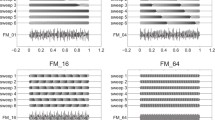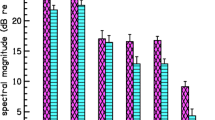Abstract
MOST naturally occurring sounds are modulated in amplitude or frequency; important examples include animal vocalizations and species-specific communication signals in mammals, insects, reptiles, birds and amphibians1-9. Deciphering the information from amplitude-modulated (AM) sounds is a well-understood process, requiring a phase locking of primary auditory afferents to the modulation envelopes10-12. The mechanism for decoding frequency modulation (FM) is not as clear because the FM envelope is flat (Fig. 1). One biological solution is to monitor amplitude fluctuations in frequency-tuned cochlear filters as the instantaneous frequency of the FM sweeps through the passband of these filters. This view postulates an FM-to-AM transduction whereby a change in frequency is transmitted as a change in amplitude13-14. This is an appealing idea because, if such transduction occurs early in the auditory pathway, it provides a neurally economical solution to how the auditory system encodes these important sounds. Here we illustrate that an FM and AM sound must be transformed into a common neural code in the brain stem. Observers can accurately determine if the phase of an FM presented to one ear is leading or lagging, by only a fraction of a millisecond, the phase of an AM presented to the other ear. A single intracranial image is perceived, the spatial position of which is a function of this phase difference.
Similar content being viewed by others
References
Simmons, J. A. Science 203, 16–21 (1979).
Bailey, W. J., Greenfield, M. D. & Shelly, T. E. J. Insect Behav. 6, 141–154 (1993).
Dear, P. S., Simmons, J. A. & Fritz, J. Nature 364, 620–623 (1993).
Coscia, E. M., Phillips, P. D. & Fentress, J. C. Bioacoustics 3, 275–293 (1991).
Robisson, P., Aubin, T. & Bremond, J. Ethology 94, 279–290 (1993).
Huber, F. & Thorson, J. Scient. Am. 253 (6), 60–68 (1985).
Ryan, M. J. & Wilczynski, W. Science 240, 1786–1788 (1988).
Klump, G. M. & Langemann, U. Adv. Bioacoust. 83, 353–359 (1992).
Brillet, C. & Paillette, M. Bioacoustics 3, 33–44 (1991).
Smith, R. & Brachman, M. Hearing Res. 2, 123–133 (1980).
Javel, E. J. acoust. Soc. Am. 68, 133–146 (1980).
Schreiner, C. E. & Langner, G. in Auditory Function (eds Edelman, G. M., Gall, W. E. & Cowan, W. M.) 337–361 (Wiley, New York, 1988).
Zwicker, E. Acustica 2, 125–133 (1952).
Henning, G. B. J. acoust. Soc. Am. 68, 446–454 (1980).
Masataka, N. Primates 24, 40–51 (1983).
Shu, Z. J., Swindale, N. V. & Cynader, M. S. Nature 364, 721–723 (1993).
Mendelson, J. R. & Cynader, M. S. Brain Res. 327, 331–335 (1985).
Lord Rayleigh ( J. W. Strutt ) Nature 14, 32–33 (1876).
Lord Rayleigh ( J. W. Strutt ) Phil. Mag. (Ser. 6) 13, 214–220 (1907).
Henning, G. B., Hertz, B. G. & Broadbent, D. E. Vision Res. 15, 887–898 (1975).
Carlson, C. R., Anderson, C. H. & Moeller, J. R. Invest. Ophthalmol. Vis. Sci. (suppl.), 165–166 (1980).
Jamar, J. H. T., Kwakman, F. T. & Koenderink, J. J. Vision Res. 24, 243–249 (1984).
Zhou, Y. & Baker, C. L. Jr Science 261, 98–101 (1993).
Kuwada, S., Yin, T. C. T. & Wickesberg, R. E. Science 206, 586–588 (1979).
Yin, T. C. T. & Chan, C. K. J. Neurophysiol. 64, 465–487 (1990).
Carr, C. E. & Konishi, M. J. Neurosci. 10, 3227–3246 (1990).
Whitfield, I. C. & Evans, E. F. J. Neurophysiol. 28, 655–672 (1965).
Rees, A. & Moller, A. R. Hearing Res. 10, 301–330 (1983).
Author information
Authors and Affiliations
Rights and permissions
About this article
Cite this article
Saberi, K., Haftert, E. A common neural code for frequency- and amplitude-modulated sounds. Nature 374, 537–539 (1995). https://doi.org/10.1038/374537a0
Received:
Accepted:
Issue Date:
DOI: https://doi.org/10.1038/374537a0
- Springer Nature Limited
This article is cited by
-
Assessing the Role of Place and Timing Cues in Coding Frequency and Amplitude Modulation as a Function of Age
Journal of the Association for Research in Otolaryngology (2017)
-
Use of Amplitude Modulation Cues Recovered from Frequency Modulation for Cochlear Implant Users When Original Speech Cues Are Severely Degraded
Journal of the Association for Research in Otolaryngology (2014)
-
Effects of Noise Reduction on AM and FM Perception
Journal of the Association for Research in Otolaryngology (2013)
-
Temporal-Envelope Reconstruction for Hearing-Impaired Listeners
Journal of the Association for Research in Otolaryngology (2012)
-
Quantifying Envelope and Fine-Structure Coding in Auditory Nerve Responses to Chimaeric Speech
Journal of the Association for Research in Otolaryngology (2009)





